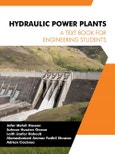Hydraulic Power Plants is a textbook for engineering students which explains the construction of hydraulic power plants. The book presents the theory of the working process for each part, i.e. the kinematics and molecular dynamics of liquids flowing through hydraulic machines and systems. The information is presented in a simple manner necessary for understanding their operational conditions and basic numerical relationships.
The chapters explain concepts with several drawings and charts to aid the reader, along with relevant specifications, working examples and solved problems, which can be applied in designing practice and maintenance of hydroelectric power plants, pumping stations and pump installations.
Hydraulic Power Plants emphasizes the need of young engineers to acquire knowledge about efficiency in using the tools for the study and design for components of hydraulic power plants such as turbines, pumps and penstocks in a straightforward format, making it an ideal reference for introductory hydraulics and mechanical engineering courses.
Table of Contents
Chapter 1 The Momentum Equation and Its Application
1.1. Momentum and Fluid Dynamic Force
1.2. Application of Momentum Equation
1.2.1. Force Exerted by the Fluid Jet on a Flat Plate
1.2.2. Velocity Diagram (General)
1.3. Bernoulli's Equation for Relative Motion
Chapter 2 Impulse Water Turbine
2.1. Components of the Pelton Turbine
2.2. Theory of Pelton Turbine
2.2.1. Step by Step Examples
2.3. Power Regulation Mechanisms
2.4. Supply and Discharge System
Chapter 3 Reaction Turbines
3.1. Type of Reaction Turbine
3.2. Construction of Reaction Turbine
3.3. Theory of Reaction Turbine
3.4. Efficiency of Reaction Turbines
3.5. Flow-Rate Through Reaction Turbine
3.6. Velocity Triangle for Reaction Turbine
3.7. Draft Tube
3.8. Net Head
3.9. Working Properties of Reaction Turbines
3.10. Power Regulating Mechanisms
3.11. Supply and Discharge Systems
Chapter 4 Similarity Laws for Turbine Specific Speed and Cavitations
4.1. Similarity Laws
4.2. Cavitation in Turbines
4.3. Turbine Selection
4.4. Marking Types of Turbine
4.5. Hydraulic Turbines Classification and Selection
Chapter 5 Centrifugal and Positive Displacement Pumps
5.1. Centrifugal Pumps
5.2. Classification and Structure of the Centrifugal Pumps
5.3. Theory of Centrifugal Pumps
5.4. Head of the Centrifugal Pumps
5.5. Force and Power of Centrifugal Pumps
5.6. Efficiencies of Centrifugal Pumps
5.7. Flow Rate Throughout the Centrifugal Pump
5.8. Net Positive Suction Head (Npsh)
5.8.1. Net Positive Suction Head Available (Npsha)
5.8.2. Net Positive Suction Head Required (Npshr)
5.8.3. Negative Suction Lift
5.9. Cavitation in Pump
5.10. Similarity Laws
5.11. Characteristic Curves for Various Working Conditions
5.12. Pump Selection and Performance Charts
5.13. Pump as Turbine
5.13.1. Pump Turbine Classification and Selection
5.14. Positive Displacement Pumps
5.14.1. Reciprocating Pumps Classification
5.14.2. Theory of Reciprocating Pumps
5.14.3. Characteristics of Reciprocating Pumps
5.14.4. Air Vessel
5.15. Rotary Positive Displacement Pumps
5.15.1. Gear Pumps
5.15.2. Screw Pumps
5.15.3. Vane Pumps
5.15.4. Axial Piston Pumps
5.15.5. Radial Piston Pumps
5.15.6. General Pumping Formulas
References
Subject Index
Author
- Jafar Mehdi Hassan
- Salman Hussien Omran
- Laith Jaafer Habeeb
- Alamaslamani Ammar Fadhil Shnawa








